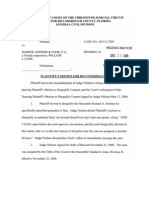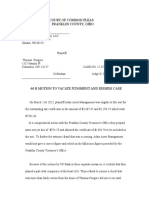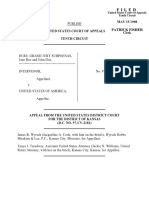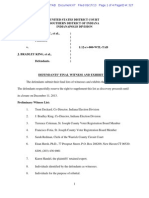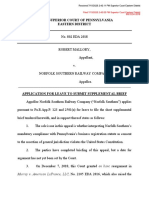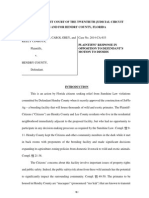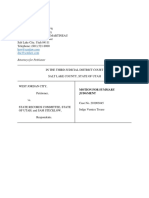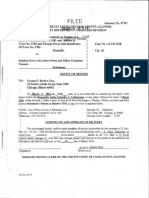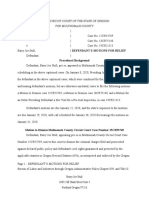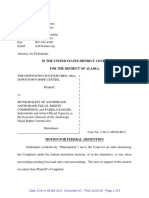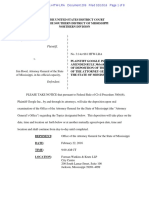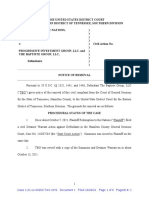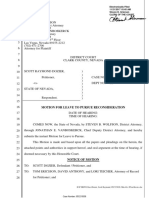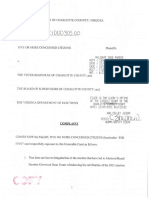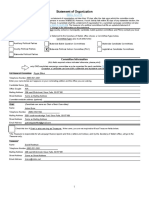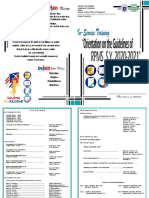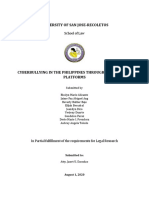Legal Brief: Motion to Dismiss
Uploaded by
Pat PowersLegal Brief: Motion to Dismiss
Uploaded by
Pat PowersSTATE OF SOUTH DAKOTA ) IN CIRCUIT COURT
) SS.
COUNTY OF LAWRENCE ) FOURTH JUDICIAL CIRCUIT
NICHOLE BRAITHWAIT, )
) Case No. 40CIV24-000221
Petitioner, )
)
v. ) RESPONDENTS’ BRIEF IN SUPPORT
) OF MOTION TO DISMISS, AND
BOB EWING, RICHARD SLEEP, ) RESPONSE TO AFFIDAVIT AND
BRANDON FLANAGAN, ERIC ) APPLICATION FOR WRIT OF
JENNINGS AND RICK TYSDAL, in their ) MANDAMUS
capacities as Commissioner of Lawrence )
County, BRENDA MCGRUDER, in her )
capacity as the Lawrence County Auditor, )
and BRUCE OUTKA, in his capacity as the )
Lawrence County Deputy State’s Attorney, )
)
Respondents. )
COME NOW Respondents, by and through their counsel, Sara Frankenstein of
Gunderson, Palmer, Nelson & Ashmore, LLP, and hereby submit this brief in support of
Respondents’ Motion to Dismiss the Affidavit and Application for Writ of Mandamus pursuant
to SDCL § 15-6-12(b) and SDCL § 21-29-2.
TABLE OF CONTENTS
Facts .................................................................................................................................... 3
Legal Standard .................................................................................................................... 4
1. Motions to Dismiss ............................................................................................ 4
2. Writs of Mandamus............................................................................................. 7
Argument and Authorities................................................................................................... 8
I. The Affidavit and Application for Writ of Mandamus should
be dismissed with prejudice .................................................................................... 8
A. A petition for a writ of mandamus is inappropriate because of the
doctrine of res judicata ................................................................................ 9
Filed: 8/16/2024 6:30 PM CST Lawrence County, South Dakota 40CIV24-000221
1. Petitioner’s prior case covers the exact subject matter of the
current case ......................................................................................... 10
2. A final judgment on the merits was entered in the previous case ....... 12
3. The parties in the two actions are the same ......................................... 14
4. A full and fair opportunity to litigate the issue was provided in
the prior adjudication .......................................................................... 14
II. Substantive Response to Affidavit and Application for Writ of Mandamus .........16
A. Petitioner’s Proposed Ordinance Is Contrary To State And Federal Law. ..... 17
B. Petitioner is not entitled to place an initiated ordinance on a ballot if the
initiated ordinance would violate state or federal law .................................... 18
1. Petitioner’s cited authority and cases are either inapposite or
distinguishable .................................................................................... 19
2. If the County did not reject the petition, litigation would have
Likely ensued placing the County in a conundrum ............................ 25
C. Local election ordinances are field preempted ................................................ 28
D. Most items of the petition is either duplicative, in conflict with, or is
preempted by state or federal law ................................................................... 30
1. Petition item one requiring only “paper ballots” is either void
or in conflict with state law................................................................ 30
i. Physical paper ballots ......................................................................31
ii. “Paper ballots” as opposed to “optical scan ballots” ......................32
2. Petition item two duplicates and conflicts with existing state law .......36
3. Petition item three’s prohibition of electronic voting devices
(i.e. ExpressVote machines) is preempted by both state law and
HAVA ..................................................................................................37
4. Petition item four – No county ordinance may dictate a
municipality, school district, or any other election district’s use
of electronic tabulator devices ..............................................................40
5. Petition item five’s language conflicts with South Dakota law
-2-
Filed: 8/16/2024 6:30 PM CST Lawrence County, South Dakota 40CIV24-000221
Regarding when ballots are disqualified ...............................................41
III. The Court should deny vague requests to order Lawrence County “to comply
with federal and state law.” ...................................................................................44
IV. The Court cannot and should not order Respondents to “articulate and
coordinate with Petitioner implementation of unbiased ballot language”
different then the petition language ......................................................................45
Conclusion .........................................................................................................................47
FACTS
Petitioner’s allegations in her Affidavit and Application for Writ of Mandamus, while not
being deemed as admitted, 1 can be summarized as follows: Petitioner, Nichole Braithwait, is a
resident and registered voter of Lawrence County, South Dakota. Petitioner circulated a petition
and helped obtain roughly 1,300 signatures. She submitted her petition to the County Auditor,
who filed the petition and presented it to the Board of County Commissioners (“Commission”) at
the next scheduled meeting.
At the meeting, the Commission reviewed the petition for initiated ordinance. The
petition for the initiative ordinance stated:
AN ORDINANCE DEFINING THE CONDUCT OF ELECTIONS WITHIN
LAWRENCE COUNTY
BE IT ORDAINED by the Board of County Commissioners of Lawrence County
that the following rules regarding elections in Lawrence County, are hereby
adopted:
From the effective date of this ordinance, elections in Lawrence County shall be
held at times and places as required by SDCL 12-2 and this ordinance.
1. All elections in Lawrence County shall be conducted by paper ballot only.
2. Tabulation of votes shall be by hand count after polls are closed in accordance
with SDCL 12-20.
3. Electronic voting devices, of any kind, are prohibited.
1
“A 12(b)(5) motion ‘does not admit conclusions of the pleader either in fact or law.’” Nygaard v. Sioux
Valley Hospitals & Health System, 2007 S.D. 34, ¶ 9, 731 N.W.2d 184, 190 (quoting Akron Savings Bank
v. Charlson, 158 N.W.2d 523, 524 (1968)).
-3-
Filed: 8/16/2024 6:30 PM CST Lawrence County, South Dakota 40CIV24-000221
4. Electronic tabulation devices, of any kind, are prohibited.
5. Absentee ballots properly obtained and marked by the individual voter in
accordance with SDCL 12-19 shall be tabulated by hand after polls close.
Ballots received after 7 pm on election day shall be disqualified.
6. The establishment of vote centers, or the like, in Lawrence County, is
prohibited.
The Commissioners rejected the petition, citing that the under South Dakota Supreme Court case
law, initiated ordinances could not enact something that the Commission itself could not enact.
Thereafter, Petitioner initiated an appeal pursuant to Chapter 7-8. Braithwait v. Ewing, et
al., 40CIV24-000114, Affidavit and Application for Notice of Appeal. See Exhibit A to
Affidavit of Sara Frankenstein filed herewith for the convenience of the Court. The case was
dismissed with prejudice on June 26, 2024. See Exhibit D to Affidavit of Sara Frankenstein. In
that prior case, Petitioner appealed the Commission’s decision to reject the petition. Petitioner
sought her appeal pursuant to SDCL § 7-8-32.
The County moved to dismiss for improper service and because the appeal was time
barred. See Braithwait v. Ewing, et al., 40CIV24-000114, Respondents’ Motion to Dismiss and
Memorandum in Support of the Motion to Dismiss, Exhibit B, Affidavit of Frankenstein. On
June 26, 2024, the circuit court dismissed the appeal with prejudice. See Exhibit D, Affidavit of
Frankenstein. A notice of entry of order was filed and served on July 12, 2024. Id.
Petitioner now seeks to relitigate the Commission’s decision to reject her petition through
the instant petition for writ of mandamus. Petitioner’s petition for writ of mandamus should be
dismissed. Petitioner has not appealed the circuit court’s order dated June 26, 2024.
LEGAL STANDARD
1. Motions to Dismiss
When considering a motion to dismiss pursuant to SDCL § 15-6-12(b), a court confines
its review to the facts alleged in the complaint and matters “embraced by the pleadings . . . .”
-4-
Filed: 8/16/2024 6:30 PM CST Lawrence County, South Dakota 40CIV24-000221
Mattes v. ABC Plastics, Inc., 323 F.3d 695, 698 n.4 (8th Cir. 2003) (citing Porous Media Corp.
v. Pall Corp., 186 F.3d 1077, 1079 (8th Cir. 1999)). “A motion to dismiss under SDCL 15-6-
12(b) tests the legal sufficiency of the pleading, not the facts which support it. For purposes of
the pleading, the court must treat as true all facts properly pled in the complaint and resolve all
doubts in favor of the pleader.” Nygaard v. Sioux Valley Hospitals & Health System, 2007 S.D.
34, ¶ 9, 731 N.W.2d 184, 190 (quoting Guthmiller v. DeLoitte & Touche, LLP, 2005 S.D. 77,
¶ 4, 699 N.W.2d 493, 496). “Motions to dismiss under Rule 12(b)(5) test only the legal
sufficiency and not the facts of the pleading. Fenske Media Corp. v. Banta Corp., 2004 S.D. 23,
¶ 7, 676 N.W.2d 390, 393 (citing Stumes v. Bloomberg, 1996 S.D. 93, ¶ 6, 551 N.W.2d 590, 593
(citations omitted)). “While the court must accept allegations of fact as true when considering a
motion to dismiss, the court is free to ignore legal conclusions, unsupported conclusions,
unwarranted inferences and sweeping legal conclusions cast in the form of factual allegations.”
Nygaard, 2007 S.D. 34, ¶ 9 (quoting Wiles v. Capitol Indemnity Corp., 280 F.3d 868, 870 (8th
Cir. 2002)); see also Sisney v. Best, Inc., 2008 S.D. 70, ¶ 7, 754 N.W.2d 804 (Courts “are not
bound to accept as true a legal conclusion couched as a factual allegation.”) (citing Bell Atlantic
Corp. v. Twombly, 550 U.S. 544 (2007)).
“Ultimately, the complaint must allege facts, which, when taken as true, raise more than a
speculative right to relief.” Sisney v. Reisch, 2008 S.D. 72, ¶ 6, 754 N.W.2d 813, 817 (citing
Twombly, 550 U.S. at 555). In fundamental terms, subject matter jurisdiction is the “court’s
competence to hear and determine cases of the general class to which proceedings in question
belong; the power to deal with the general subject involved in the action[.]” Bingham Farms
Trust v. City of Belle Fourche, 2019 S.D. 50, ¶ 12, 932 N.W.2d 916, 919 (quoting In re Heupel
-5-
Filed: 8/16/2024 6:30 PM CST Lawrence County, South Dakota 40CIV24-000221
Family Revocable Tr., 2018 S.D. 46, ¶ 25, 914 N.W.2d 571, 578 (quoting Sazama v. State ex rel.
Muilenberg, 2007 S.D. 17, ¶ 14, 729 N.W.2d 335, 342)).
“Therefore, ‘subject matter jurisdiction is dependent only upon the nature of the
proceeding and the relief sought.’” Id. (quoting Sazama, 2007 S.D. 17, ¶ 14, 729 N.W.2d at
341). When there is an attack on subject matter jurisdiction, “the circuit court does not assume
the allegations in the complaint are accurate.” Alone v. C. Brunsch, Inc., 2019 S.D. 41, ¶ 12, 931
N.W.2d 707, 711 (citing Hutterville Hutterian Brethren, Inc. v. Waldner, 2010 S.D. 86, ¶ 20, 791
N.W.2d 169, 175).
“Because at issue in a factual 12(b)(1) motion is the [circuit] court's jurisdiction—
its very power to hear the case—there is substantial authority that the [circuit]
court is free to weigh the evidence and satisfy itself as to the existence of its
power to hear the case.” Osborn v. United States, 918 F.2d 724, 730 (8th Cir.
1990). To resolve the question, the court may hold hearings, consider live
testimony, or review affidavits and documents. See id.; Wright & A. Miller,
Federal Practice & Procedure § 1350 at 243–49 (3d ed. 2004).
Id. Circuit courts are only authorized to hear cases constitutionally or statutorily authorized. Id.
¶ 13 (citation omitted). “[A] motion to dismiss based on res judicata properly falls under
Federal Rules of Civil Procedure 12(b)(1). On a motion to dismiss for lack of subject matter
jurisdiction pursuant to Rule 12(b)(1), the plaintiff bears the burden of establishing that the court
has subject matter jurisdiction.” Rizvi v. McClure, 597 F.Supp.2d 63, 66 (D.D.C. Feb. 17, 2009)
(citing Evans v. B.F. Perkins Co., 166 F.3d 642, 647 (4th Cir. 1999); Rasul v. Bush, 215
F.Supp.2d 55, 61 (D.D.C. 2002) (citing McNutt v. Gen. Motors Acceptance Corp., 298 U.S. 178,
182-83 (1936))). When there is no longer a dispute about Plaintiffs’ legal rights, in addition to
dismissal under SDCL 12(b)(1), the case should be dismissed pursuant to SDCL 15-6-12(b)(5)
because it no longer states a cause of action for which relief can be granted. See Sisney v. Best,
Inc., 2008 S.D. 70, ¶¶ 7-8, 754 N.W.2d 804, 808-809 (Plaintiffs have no plausible claim for
-6-
Filed: 8/16/2024 6:30 PM CST Lawrence County, South Dakota 40CIV24-000221
relief). Therefore, before this Court can decide on whether to issue a writ of mandamus, the
court must first determine the jurisdictional question.
2. Writs of Mandamus
“The writ of mandamus must be issued in all cases where there is not a plain, speedy and
adequate remedy, in the ordinary course of law.” SDCL § 21-29-2. “The nature of the writ of
mandamus is an extraordinary remedy that will issue only when the duty to act is clear.”
Brendtro v. Nelson, 2006 S.D. 71, ¶ 13, 720 N.W.2d 670, 674. The South Dakota Supreme
Court has repeatedly recognized that:
Mandamus is a potent, but precise remedy. Its power lies in its expedience; its
precision in its narrow application. It commands the fulfillment of an existing
legal duty, but creates no duty itself, and acts upon no doubtful or unsettled right.
To prevail in seeking a Writ of Mandamus, the petitioner must have a clear legal
right to the performance of the specific duty sought to be compelled and the
respondent must have a definite legal obligation to perform that duty.
Id. (quoting Sorrells v. Queen of Peace Hosp., 1998, S.D. 12, ¶ 6, 575 N.W.2d 240, 242)
(citations omitted, emphasis added). Mandamus relief is only appropriate when the duty to act is
unequivocal. Argus Leader v. Hagen, 2007 S.D. 96 ¶¶ 8, 9, 739 N.W.2d 475, 478-479. The
remedy does not lie where the obligation to be compelled is of doubtful validity. Crowley v.
Spearfish Independent School Dist., 445 N.W.2d 308, 311 (S.D. 1989). “Mandamus … is
available to compel performance of ministerial duties. However, in the case of discretionary
functions, the question is whether the particular entity abused its discretion.” Black Hills Cent.
R. Co. v. City of Hill City, 2003 S.D. 152, ¶ 14, 674 N.W.2d 31, 34.
The discretion must be exercised under the established rules of law, and it may be
said to be abused within the foregoing rule where the action complained of has
been arbitrary or capricious, or based on personal, selfish, or fraudulent motives,
or on false information, or on a total lack of authority to act, or where it amounts
to an evasion of a positive duty ... or where the exercise of the discretion is in a
manner entirely futile and known by the officer to be so and there are other
methods which if adopted would be effective.
-7-
Filed: 8/16/2024 6:30 PM CST Lawrence County, South Dakota 40CIV24-000221
Id. at ¶ 14, at 34–35. “A standard definition of abuse of discretion has not been adopted by” the
South Dakota Supreme Court, however. M.G. Oil Co. v. City of Rapid City, 2011 S.D. 3, ¶ 13,
793 N.W.2d 816, 821. Abuse of discretion is only found where there “is a fundamental error of
judgment, a choice outside the range of permissible choices, a decision, which, on full
consideration, is arbitrary or unreasonable.” Id.
ARGUMENT AND AUTHORITIES
I. The Affidavit and Application for Writ of Mandamus should be dismissed with
prejudice.
Petitioner Braithwait (“Petitioner”) has already unsuccessfully appealed the County’s
decision to reject her petition for an initiated ordinance. Braithwait v. Ewing, et al., Case No.
40CIV24-000114 (Exhibit D to Affidavit of Sara Frankenstein, Order of Dismissal with
Prejudice signed by the Honorable Judge Comer dated June 26, 2024). Generally, when an
individual petitions for a writ of mandamus, there must be no other available remedy at law. See
SDCL § 21-29-1. 2 South Dakota statutes, however, also authorize citizens to appeal a board of
county commissioners’ decision in Chapter 7-8. SDCL §§ 7-8-27 through 7-8-32. 3
2
SDCL § 21-29-1. Power to issue writ—Purpose for which used.
The writ of mandamus may be issued by the Supreme and circuit courts, to any inferior tribunal,
corporation, board, or person, to compel the performance of an act which the law specially
enjoins as a duty resulting from an office, trust, or station; or to compel the admission of a party
to the use and enjoyment of a right or office to which he is entitled, and from which he is
unlawfully precluded by such inferior tribunal, corporation, board, or person.
SDCL § 21-29-2. Writ issued when ordinary remedy inadequate—Application and affidavit.
The writ of mandamus must be issued in all cases where there is not a plain, speedy, and adequate
remedy, in the ordinary course of law. It must be issued upon affidavit, upon the application of
the party beneficially interested.
3
SDCL § 7-8-32. Appeal as exclusive remedy—Restrictions.
Appeal to the circuit court from decisions of the board of county commissioners, as provided in
this chapter, is an exclusive remedy. Judicial review of county commission action shall be
allowed only as provided in §§ 7-8-27, 7-8-28, 7-8-29, 7-8-30, and 7-8-31.
-8-
Filed: 8/16/2024 6:30 PM CST Lawrence County, South Dakota 40CIV24-000221
Petitioner was allowed to choose either route to challenge the County’s decision to reject
her petition for initiative ordinance. The two routes essentially achieve the same end result, but
the routes are mutually exclusive. See id. 4 If an individual unsuccessfully pursues an appeal
under Chapter 7-8, the individual cannot later pursue the same relief through a petition for a writ
of mandamus. In such situations, the doctrine of res judicata bars the petition for writ of
mandamus because the claim was already decided on appeal. Importantly, mandamus relief
would be permissible had the Petitioner not sought an appeal pursuant to Chapter 7-8. See Vitek
v. Bon Homme County Board of Comm’rs, 2002 S.D. 45, 644 N.W.2d 231 (explaining that an
individual may petition for a writ of mandamus or pursue an appeal under Chapter 7-8). When
an appeal is sought, however, the unsuccessful appeal will act as the exclusive remedy. See
SDCL § 7-8-32; see also Healy Ranch, Inc. v. Healy, 2022 S.D. 43, ¶ 42, 978 N.W.2d 786, 799
(outlining the elements for res judicata). Therefore, Petitioner’s appeal pursuant to chapter 7-8
bars the Petitioner’s request for mandamus relief under the doctrine of claim preclusion.
A. A petition for a writ of mandamus is inappropriate because of the doctrine of res
judicata.
The doctrine of res judicata bars this petition for writ of mandamus because a court of
competent jurisdiction already ordered a dismissal in a previous court proceeding regarding the
same cause of action. South Dakota recognizes two subsets of res judicata: “issue preclusion and
claim preclusion.” Healy Ranch, Inc., 2022 S.D. 43, ¶ 40, 978 N.W.2d at 798 (quoting Am.
Family Ins. Grp. v. Robnik, 2010 S.D. 69, ¶ 15, 787 N.W.2d 768, 774). Our case focuses only on
claim preclusion. “Claim preclusion refers to the effect of a judgment in foreclosing litigation of
a matter that never has been litigated, because of a determination that it should have been
4
Whether SDCL § 7-8-27 through § 7-8-32 precludes a writ of mandamus from being used is not the
issue. Rather, Petitioner sought recourse under the appeal statutes in chapter 7-8 and lost. She cannot
now seek the same remedies arising under the same cause of action through a writ of mandamus.
-9-
Filed: 8/16/2024 6:30 PM CST Lawrence County, South Dakota 40CIV24-000221
advanced in an earlier suit.” Id. (citing Am. Family Ins. Grp., 2010 S.D. 69, ¶ 15, 787 N.W.2d at
774 (quoting Migra v. Warren City Scho. Dist. Bd. of Educ., 465 U.S. 75, 77 n. 1 (1984))).
Claim preclusion essentially prohibits the cause of action itself. Id. ¶ 41. To determine whether
a cause of action is barred from being relitigated, courts have developed a four-part test.
(1) the issue in the prior adjudication must be identical to the present issue, (2)
there must have been a final judgment on the merits in the previous case, (3) the
parties in the two actions must be the same or in privity, and (4) there must have
been a full and fair opportunity to litigate the issues in the prior adjudication.
Id. ¶ 42, 978 N.W.2d at 799 (citations omitted).
The present case meets all four elements, requiring this Court to dismiss the petition for
writ of mandamus. See SDCL § 15-6-12(b)(1). The prior litigation attacked the County’s
decision to reject the Petitioner’s petition for an initiative ordinance. The case was dismissed
with prejudice acting as an adjudication on the merits. The parties in the prior suit are identical
to the current petition for writ of mandamus. See Braithwait v. Ewing, et al., 40CIV24-000114;
Affidavit of Sara Frankenstein. And there was a full and fair opportunity to litigate whether the
County’s prior rejection of the Petitioner’s petition for an initiative ordinance was proper. Since
all four elements are met, this petition for a writ of mandamus is barred from being adjudicated
based on the doctrine of res judicata.
1. Petitioner’s prior case covers the exact subject matter of the current case.
Claim preclusion requires courts to determine whether the legal question posed in either
suit was the same. Healy Ranch, Inc., 2022 S.D. 43, ¶ 44, 978 N.W.2d at 799 (citing Farmer v.
S.D. Dep’t Rev. & Reg., 2010 S.D. 35, ¶ 10, 781 N.W.2d 655, 660). “The test is a query into
whether the wrong sought to be redressed is the same in both actions.” Id. ¶ 45 (quoting Glover
v. Krambeck, 2007 S.D. 11, ¶ 18, 727 N.W.2d 801, 805 (cleaned up)). “If the claims arose out of
a single act or dispute and one claim has been brought to a final judgment, then all other claims
-10-
Filed: 8/16/2024 6:30 PM CST Lawrence County, South Dakota 40CIV24-000221
arising out of that same act or dispute are barred.” Id. (quoting Farmer, 2010 S.D. 35, ¶ 10, 781
N.W.2d at 660).
The Petitioner’s two legal actions cover the same alleged “wrong.” The final disposition
of the earlier case requires immediate dismissal of the latter. Petitioner stated the grounds for her
appeal was whether “[t]he decision violates statutory provisions related to initiative ordinance
petitions.” See Affidavit of Frankenstein, Exhibit A. The very same issue is now before this
Court on a petition for writ. Petitioner is seeking this Court to order the County “to schedule an
election in the next 60 days pursuant to SDCL § 7-18A-13.” Petitioner’s Affidavit and
Application for Writ of Mandamus p. 16, ¶ 1. The two legal issues are identical.
Even if the two legal theories are not identical, the same alleged harm is being
adjudicated in both cases. Healy Ranch, Inc., 2022 S.D. 43, ¶ 49, 978 N.W.2d at 800. The
appeal arose from the County’s rejection of the Petitioner’s petition for initiative ordinance. The
remedy’s sought in both actions are the same, i.e., to have the initiative ordinance placed on the
ballot for a vote of the voters.
Petitioner has acknowledged that both her petition for writ of mandamus and her earlier
appeal was meant to remedy the same alleged harm. Braithwait v. Ewing, et al., 40CIV24-
000114, Petitioner’s Response to the Motion to Dismiss. In a brief for her appeal, the Petitioner
explained that her potential attorney discussed her legal options, including appealing under
Chapter 7-8 and filing a petition for writ of mandamus. Id. p. 3. Ultimately, she elected to do
both -- appeal under Chapter 7-8 and petition for a writ of mandamus. Id. p. 4. Therefore, the
Petitioner’s appeal is – and was designed to be – functionally the same cause of action as her
current petition for writ of mandamus. Thus, element one is met.
-11-
Filed: 8/16/2024 6:30 PM CST Lawrence County, South Dakota 40CIV24-000221
2. A final judgment on the merits was entered in the previous case.
Traditionally, a final judgment on the merits is defined as a judgment “based on legal
rights rather than matters of procedure and jurisdiction.” Healy Ranch, Inc., 2022 S.D. 43, ¶ 50,
978 N.W.2d at 801 (citations omitted). However, courts have extended this definition over time.
Id.
Indeed, as the Supreme Court has observed, “over the years the meaning of the
term ‘judgment on the merits’ has gradually undergone change ….” Semtek Int’l
Inc. v. Lockheed Martin Corp., 531 U.S. 497, 507, 121 S.Ct. 1021, 1025, 149 L.
Ed. 2d 32 (2001) (internal quotations marks omitted) (citation omitted). For
purposes of res judicata, the term ‘has come to be applied to judgments … that do
not pass upon the substantive merits of a claim ….” Id.
Id. ¶ 52 (emphasis in opinion). Multiple jurisdictions agree that “[a] dismissal with prejudice is
considered a judgment on the merits preventing subsequent litigation between parties on the
dismissed claim.” LaCour v. Marshalls of California, LLC, 94 Cal.App.5th 1172, 1191 (2023)
(string cite omitted); see also Kim v. Reins International California, Inc., 459 P.3d 1123, 1134
(Cal. 2020) (string cite omitted) (“A dismissal with prejudice is considered a judgment on the
merits preventing subsequent litigation between the parties on the dismissed claim.”); Richey v.
Vasquez, 986 S.W.2d 611, 612 (Tex. 1999) (“[I]t is well established that a dismissal with
prejudice functions as a final determination on the merits.”) (quoting Mossler v. Shields, 818
S.W.2d 752, 754 (Tex. 1991) (per curium)); Orr v. Hudson, 374 S.W.2d 686, 692 (Ark. 2010)
(finding a dismissal with prejudice operated as an adjudication on the merits of the plaintiff’s
claims barring the re-litigation of those claims because of claim preclusion); see generally
Rinehart v. Locke, 454 F.2d 313, 315 (7th Cir. 1971) (“a district court which dismisses a
complaint for failure to state a claim, but which does not specify that the dismissal is without
prejudice, is res judicata as to the then-existing claim which it appears plaintiff was attempting.
… If plaintiff is unsuccessful, his recourse is to appeal.”).
-12-
Filed: 8/16/2024 6:30 PM CST Lawrence County, South Dakota 40CIV24-000221
The general understanding is that “the decision may not have examined the substantive
merits of the various claims, it was nonetheless a final judgment on the merits entitled to
preclusive effect because it settled the rights and obligations of the respective parties.” Healy
Ranch, Inc., 2022 S.D. 43, ¶ 53, 978 N.W.2d at 801-02 (citing Am. Nat. Bank & Tr. Co. v. City
of Chicago, 826 F.2d 1547, 1553 (7th Cir. 1987)) (“A decision may be ‘on the merits’ for
purposes of preclusion even though the court did not resolve the merits.”); see also United States
v. Or. Lumber Co., 260 U.S. 290, 300–01 (1922) (“Whether based on a plea of the statute of
limitations or on a failure to prove substantive allegations of fact, therefore, the result of the
judgment is the same, ... that plaintiff has no case[.]”).
Here, the prior decision was dismissed with prejudice. Braithwait v. Bob Ewing, et al.,
Case No. 40CIV24-000114 (Order of Dismissal with Prejudice signed June 26, 2024). As
mentioned above, an order dismissing a case with prejudice is an adjudication on the merits. The
order dismissing the case with prejudice is enough to satisfy the second element for claim
preclusion.
The Petitioner’s appeal, however, also bars her from seeking mandamus relief because
SDCL § 7-8-32 is an exclusive remedy. The statute states, “Appeal to the circuit court from
decisions of the board of county commissioners, as provided in this chapter, is an exclusive
remedy.” SDCL § 7-8-32. By appealing under chapter 7-8, the Petitioner submitted herself to
the statute’s exclusive authority, precluding her from initiating a second legal action regarding
the County’s decision. Simply put, she cannot seek mandamus relief in the instant action
because she already appealed the issue and lost.
Therefore, the court’s dismissal with prejudice acts as an adjudication on the merits
barring the Petitioner from seeking mandamus relief. The appeal also bars her petition for writ
-13-
Filed: 8/16/2024 6:30 PM CST Lawrence County, South Dakota 40CIV24-000221
of mandamus because the statute, SDCL § 7-8-32, requires the appeal to be the exclusive remedy
once the individual utilizes the appeal procedure in Chapter 7-8 for judicial review of the
Commission’s decision. Thus, the second element of claim preclusion is met.
3. The parties in the two actions are the same.
It is beyond dispute that the two cases involve the same parties. The two pleadings list
the same parties. In the first case, the Petitioner named herself as the petitioner. She also listed
“BOB EWING, RICHARD SLEEP, BRANDON FLANAGAN, ERIC JENNINGS AND RICK
TYSDAL, in their capacities as Commissioners of Lawrence County, BRENDA MCGRUDER,
in her capacity as Lawrence County Auditor, and BRUCE OUTKA, in his capacity as the
Lawrence County Deputy State’s Attorney.” Braithwait v. Ewing, et al., Case No. 40CIV24-
000114 (Order of Dismissal with Prejudice signed June 26, 2024). Clearly evidenced from the
captions in both cases, the two actions involve the same parties. Therefore, element three is met.
4. A full and fair opportunity to litigate the issue was provided in the prior
adjudication.
Petitioner was also entitled to a full and fair opportunity to litigate her appeal in her prior
case. “For a claim to be barred by res judicata, the claim need not have been actually litigated at
an earlier time. Rather, the parties only need to have been provided ‘a fair opportunity to place
their claims in the prior litigation.’” Healy Ranch, Inc., 2022 S.D. 43, ¶ 56, 978 N.W.2d at 802
(quoting Farmer, 2010 S.D. 35, ¶ 9, 781 N.W.2d at 659 (quoting Mack v. Trautner, 2009 S.D.
13, ¶ 15, 763 N.W.2d 121, 124)). Chapter 7-8 allows individuals to appeal a decision of the
board of county commissioners. See SDCL § 7-8-32. Once an individual elects to appeal the
commission’s decision pursuant to Chapter 7-8, that process becomes the exclusive remedy for
the individual. Id. If that individual is unsuccessful, the proper recourse is to appeal that case to
-14-
Filed: 8/16/2024 6:30 PM CST Lawrence County, South Dakota 40CIV24-000221
the South Dakota Supreme Court. SDCL § 15-26A-3. 5 Litigants are not entitled to file a new
case utilizing a different procedural vehicle.
In the first case, the circuit court dismissed Petitioner’s appeal with prejudice on June 26,
2024. Braithwait v. Ewing, et al., Case No. 40CIV-000114 (Order of Dismissal with Prejudice).
In that case, Petitioner was afforded a fair opportunity to place her claims before the circuit
court. In fact, Petitioner did place her claims before the circuit court. Id. (Affidavit and
Application for Notice of Appeal). In her notice of appeal, Petitioner stated:
Notice is hereby given that Nichole Braithwait, Petitioner herein, appeals to the
Circuit Court for the Fourth Judicial Circuit from the final decision rendered by
the Lawrence County Commission on 26 March 2024, denying the Petitioner’s
request to bring vote to the people of Lawrence County to decide if they wish to
hand count ballots or continue to allow machines to count ballots.
***
The grounds for this appeal are as follows:
The decision violates statutory provisions related to initiative ordinance petitions.
The decision was made without proper notice and hearing, contrary to the
requirements of due process.
5
SDCL § 15-26A-3. Judgments and orders of circuit courts from which appeal may be taken.
Appeals to the Supreme Court from the circuit court may be taken as provided in this title from:
(1) A judgment;
(2) An order affecting a substantial right, made in any action, when such order in effect
determines the action and prevents a judgment from which an appeal might be taken;
(3) An order granting a new trial;
(4) Any final order affecting a substantial right, made in special proceedings, or upon a
summary application in an action after judgment;
(5) An order which grants, refuses, continues, dissolves, or modifies any of the remedies of
arrest and bail, claim and delivery, injunction, attachment, garnishment, receivership, or deposit
in court;
(6) Any other intermediate order made before trial, any appeal under this subdivision, however,
being not a matter of right but of sound judicial discretion, and to be allowed by the Supreme
Court in the manner provided by rules of such court only when the court considers that the ends
of justice will be served by determination of the questions involved without awaiting the final
determination of the action or proceeding; or
(7) An order entered on a motion pursuant to § 15-6-11.
-15-
Filed: 8/16/2024 6:30 PM CST Lawrence County, South Dakota 40CIV24-000221
Id. To compare Petitioner’s current petition for writ, we see the same issue presented:
WHEREFORE, Petitioner requests the Court to issue Writ of Mandamus (or a
peremptory writ if the Court deems it appropriate) commanding:
1. the Respondents to schedule an election in the next 60 days pursuant to
SDCL § 7-18A-13;
2. The Respondent articulate and coordinate with Petitioner implementation of
unbiased ballot language to be clarified, as the court deems necessary, in
accordance with SDCL § 2-1-11.
3. The Respondent to convene a counting board to hand count the election, as
using the machines would be a conflict of interest;
4. Respondents be required to appear before the Court at such date and time set
forth by the Court and show cause why the acts required by the Writ have bot
been carried out and should not be required, and that the Court grant Petitioner
such other and further relief as may be equitable in the premises;
5. Such other and further relief as the Court may deem just and equitable.
The substance of the two cases at issue are nearly identical. All requests in this petition for writ
of mandamus are either the same or could have been raised in the appeal to the circuit court.
Essentially, this Court is being asked to rule on the same case under the guise of a new
procedural vehicle. Therefore, the fourth element of claim preclusion is met.
Petitioner had a fair opportunity to fully and fairly litigate these same issues in her prior
case appealing the Commission’s decision to reject her petition for initiative ordinance. All four
elements of res judicata are met. Because all the elements are met, this petition for writ of
mandamus is barred from being relitigated and this Court should dismiss the petition for writ of
mandamus under SDCL § 15-6-12(b)(1) and (5). 6
II. Substantive Response to Affidavit and Application for Writ of Mandamus
Alternatively, this Court should deny Petitioner’s requests for numerous other reasons.
First, a proposed county ordinance may not defy or conflict with state or federal law, may not be
preempted by federal law, and may not duplicate state law. Second, the Court should deny
6
Jurisdiction are split as to whether a case dismissed under res judicata should be dismissed by Rule
12(b)(1) for lack of subject matter jurisdiction or Rule 12(b)(5) for failing to state a claim upon which
relief can be granted. Under either, Petitioner’s petition for writ of mandamus should be dismissed
pursuant to the doctrine of claim preclusion.
-16-
Filed: 8/16/2024 6:30 PM CST Lawrence County, South Dakota 40CIV24-000221
vague requests to order Lawrence County “to comply with federal and state law.” Third, the
Court cannot and should not draft, nor order Lawrence County to “clarify” or “finesse”
“unbiased ballot language” different then the petition language. Each of these legal issues will
be addressed below, followed by how the items listed in the petition conflict with or duplicate
state and federal law or is otherwise preempted.
A. Petitioners’ Proposed Ordinance Is Contrary To State And Federal Law.
A petition for a writ of mandamus must be denied when the petition is demanding that the
local government act in a manner that is in direct conflict with state or federal law. See In re
Yankton County Comm’n, 2003 S.D. 109, ¶ 15, 670 N.W.2d 34, 38. The South Dakota Supreme
Court made clear in Tibbs v. Moody County Board of Commissioners, 2014 S.D. 44, ¶ 25, 851
N.W.2d 208, 217, that:
A county is a creature of statute and has only such powers as are expressly
conferred upon it by statute and such as may be reasonably implied from those
expressly granted. … In particular, SDCL 7-18A-2 gives a county the authority
to adopt ordinances as may be proper and necessary to carry into effect the
powers granted to it by law …. Yet a county may not enact an ordinance that
conflicts with state law.
Tibbs, 2014 S.D. 44, ¶ 25, 851 N.W.2d at 217 (emphasis added) (internal citations and
quotations omitted). When there is a conflict between a state or federal law and a county or
municipal ordinance, the state or federal law controls. In re Yankton County Comm’n, 2003 S.D.
109, ¶ 15, 670 N.W.2d 34, 38.
There are several ways in which a local ordinance may conflict with state law. In
that event, state law preempts or abrogates the conflicting local law. First, an
ordinance may prohibit an act which is forbidden by state law and, in that event,
the ordinance is void to the extent it duplicates state law. Second, a conflict may
exist between state law and an ordinance because one prohibits what the other
allows. And, third, state law may occupy a particular field to the exclusion of all
local regulation.
-17-
Filed: 8/16/2024 6:30 PM CST Lawrence County, South Dakota 40CIV24-000221
Id. In the case at bar, the proposed ordinance had many deficiencies including conflicts with
both state and federal law and field preemption.
B. Petitioner is not entitled to place an initiated ordinance on a ballot if the initiated
ordinance would violate state or federal law.
In Schafer v. Deuel County Commission,, 2006 S.D. 106, ¶¶ 15-16, 725 N.W.2d at 247-
49, the South Dakota Supreme Court made clear that an initiated ordinance may only go to a vote
of the voters if the issue could have been enacted by the county commission itself. Absent such
authority, a writ of mandamus may not issue because no clear legal right exists.
In Schafer, a petition for an initiated ordinance was circulated to change Deuel County’s
zoning ordinances. Id. ¶ 1, 725 N.W.2d at 243. The county commission rejected the petition,
preventing the initiated ordinance from going to a vote of the voters. Id. ¶ 2. Thereafter, the
petitioner filed a petition for writ of mandamus to require the county commission to send the
initiated ordinance to a public vote. Id.
The Schafer Court held that initiated measures cannot be used to enact an ordinance that
the county commission itself did not have the power to enact under state statute. Id. at 249.
Petitioners, through the use of initiatives, are attempting to enact amendments
which the county would not have the authority to enact under current state
statutes. Because one of the basic limitations on the right of initiative is that the
proposed ordinance or amendment must be within the power of the county board
to adopt, Petitioners proposed use of initiatives cannot be sustained. Heine Farms
[v. Yankton Cnty., 2002 S.D. 88, ¶ 16, 649 N.W.2d 597, 601].
Id. ¶ 16, at 249. Given that the initiated ordinance attempted to skirt around Deuel County’s
scope of authority and contravene state statutes, the South Dakota Supreme Court reversed the
circuit court’s peremptory writ of mandamus. Id. ¶ 16, at 249.
Much like Schafer, the initiated ordinance in this case was correctly rejected by the
Lawrence County Commission because the initiated ordinance was contrary to state and federal
-18-
Filed: 8/16/2024 6:30 PM CST Lawrence County, South Dakota 40CIV24-000221
law. As discussed below, the petition is void and preempted in multiple ways. Since the
Commission could not enact what the Petitioners are seeking, then neither can the Court require
the petition be sent to a vote of the voters for enactment. Schafer, 2006 S.D. 106, ¶ 16, 725
N.W.2d at 249. The Commission properly rejected the initiated ordinance under Schafer.
1. Petitioner’s cited authority and cases are either inapposite or distinguishable.
In paragraph 1 on pages 2-3, Petitioner seems to suggest she has a constitutional right to
petition her county government to initiate an ordinance. Case law has made clear that there is no
such constitutional right. South Dakota’s Constitution expressly reserved the power to the
people to initiate statutes and city ordinances. S.D. Const. art. 3, § 1. 7 Plain from its text,
however, the Constitution did not reserve the people’s power to initiate county ordinances.
Schafer, 2006 S.D. 106, ¶ 15, 725 N.W.2d at 249 (citing Bechen v. Moody County Board of
Commissioners, 2005 S.D. 93, ¶ 13, 703 N.W.2d 662, 665) (stating South Dakota Constitution
article 3, section 1 only applied to municipalities and did not extend county governments). In
simple terms, an initiated ordinance is possible because the Legislature enacted SDCL § 7-18A-
13, not because of S.D. Const. art. 3, § 1. Case law agrees. “Counties are creatures of statute
7
S.D. Const. art. 3, § 1. Legislative power—Initiative and referendum.
The legislative power of the state shall be vested in a Legislature which shall consist of a senate
and house of representatives. However, the people expressly reserve to themselves the right to
propose measures, which shall be submitted to a vote of the electors of the state, and also the right
to require that any laws which the Legislature may have enacted shall be submitted to a vote of
the electors of the state before going into effect, except such laws as may be necessary for the
immediate preservation of the public peace, health or safety, support of the state government and
its existing public institutions. Not more than five percent of the qualified electors of the state
shall be required to invoke either the initiative or the referendum.
This section shall not be construed so as to deprive the Legislature or any member thereof of the
right to propose any measure. The veto power of the Executive shall not be exercised as to
measures referred to a vote of the people. This section shall apply to municipalities. The enacting
clause of all laws approved by vote of the electors of the state shall be: “Be it enacted by the
people of South Dakota.” The Legislature shall make suitable provisions for carrying into effect
the provisions of this section.
-19-
Filed: 8/16/2024 6:30 PM CST Lawrence County, South Dakota 40CIV24-000221
and have no inherent authority. They have ‘only such powers as are expressly conferred [ ] by
statute and such as may be reasonably implied from those expressly granted.’” Id. 725 N.W.2d
at 248 (quoting State v. Quinn, 2001 S.D. 25, ¶ 10, 623 N.W.2d 36, 38 (quoting State v. Hansen,
75 S.D. 476, 68 N.W.2d 480, 481 (1955)); Pennington County v. State ex rel. Unified Judicial
System, 2002 S.D. 31, ¶ 10, 641 N.W.2d 127, 131). Therefore, any right to initiate a county
ordinance derives from statute, not the South Dakota constitution. See SDCL § 7-18A-13.
Next, in paragraph 7, p. 5, of her brief, Petitioner cited SDCL § 9-19-5. Title 9 of the
code deals exclusively with municipalities. Any statute regarding municipal ordinances is not
relevant here.
Next, in paragraph 8, p. 5, of her brief, Petitioner cited SDCL § 2-1-11. (“The petitions
herein provided for shall be liberally construed . . .”) Within the very statute cited is the
qualifying phrase “[t]he petitions herein provided for”. Title 2 of the code is entitled
“Legislature and Statutes”. Title 2 clearly governs state statutes, not county ordinances. South
Dakota Subsequent Injury Fund v. Federated Mut. Ins., Inc., 2000 S.D. 11, ¶ 17, 605 N.W.2d
166, 169 (stating the courts should assume “that statutes mean what they say and that legislators
have said what they meant.”). Chapter 2-1 “Initiative and Referendum” governs statewide ballot
measures (that would potentially become state statutes) and does not apply to county ordinances.
The “petitions herein provided for” referenced in SDCL § 2-1-11 are the statewide ballot
measures that could create new state statutes. Petitioner’s citation to SDCL § 2-1-11 is not
relevant to this initiated county ordinance.
Petitioner also tries to rely on South Dakota cases to justify her petition for writ of
mandamus. Petitioner cites Baker v. Atkinson, 2001 SD 49, 625 N.W.2d 265, for the proposition
that “once a petition meets the statutory requirements, such as the requisite number of signatures
-20-
Filed: 8/16/2024 6:30 PM CST Lawrence County, South Dakota 40CIV24-000221
and proper filing, the commission must act accordingly”. ⁋ 60, Affidavit and Application for
Writ of Mandamus, p. 15. This argument and Baker’s holding, however, both assume that there
is no conflict with state or federal law that would invalidate the initiative.
In Baker, the county board of commissioners rejected the petition because it was not in
the proper form. Baker, 2001 S.D. 49, ¶ 6, 625 N.W.2d at 268. In the present case, the
Lawrence County Commission rejected the petition because the initiated county ordinance
contained therein conflicts with state and federal law. See In re Yankton Cnty. Comm’n, 2003
S.D. 109, ¶ 15, 670 N.W.2d 34, 38 (listing three ways in which local ordinances “may conflict
with state law,” in which case “state law preempts or abrogates the local law”). The case at bar
does not involve the form of the petition, only the legality of the proposed measure contained
therein. Baker simply is not on point.
Petitioner also cites Dakotans for Health v. Noem, 543 F.Supp.3d 769 (D.S.D. 2021), but
that case is also inapplicable here. The Dakotans for Health court enjoined a legislative bill that
would have altered the statewide initiative and referendum petition-circulation process. Id. The
case at bar has nothing to do with the petition circulation process. Dakotans for Health spoke
nothing to whether local law, promulgated by an initiative petition or by a county commission
itself, may duplicate or conflict with state or federal law.
Petitioner relies heavily upon Bohn v. Bueno, 2024 S.D. 6, 3 N.W.3d 441, claiming the
electorate can consider whether the proposed ordinance is legal when voting for or against the
measure. Bohn, however, is also wholly irrelevant to this case. In Bohn, the City of Sturgis’
finance officer refused to certify a petition that was properly submitted. If enacted, the petition’s
initiative would have removed the position of city manager from the City’s government. Id. ¶¶
3-6, 3 N.W.3d at 445-46. As a result, the petitioner filed a petition for a writ of mandamus to
-21-
Filed: 8/16/2024 6:30 PM CST Lawrence County, South Dakota 40CIV24-000221
compel the city finance officer to certify the petition and for the city council to schedule and
carry out an election. Id. ¶ 7, 3 N.W.3d at 446. Nothing within Bohn governs how a board of
county commissioners must act when a petition is presented to them that is beyond their legal
authority to enact themselves.
Specifically, in Bohn, the Court emphasized that the case did not involve an initiative
petition; thus, causing SDCL § 9-20-4 (municipalities’ functional equivalent of counties’ SDCL
§ 7-18A-13) to be wholly inapplicable. Id. at ¶ 17, 3 N.W.3d at 448. The municipalities’
equivalent statute reads as follows:
SDCL § 9-20-4. Presentation of initiative petition to governing body—
Submission to voters.
When a petition to initiate is filed with the finance officer, the finance officer
shall present the petition to the governing body at its first ensuing regular or
special meeting. The governing body shall submit the petition to a vote in the
manner prescribed for a referendum.
Here, Petitioner utilized the county-initiated ordinance procedure under SDCL § 7-18A-13.
SDCL § 7-18-13. Board action on initiative petition—Submission to voters.
If a petition to initiate is filed with the auditor, the auditor shall present it to the
board of county commissioners at its next regular or special meeting. The board
shall enact the proposed ordinance or resolution and shall submit it to a vote of
the voters in the manner prescribed for a referendum within sixty days after the
final enactment. However, if the petition is filed within three months prior to the
primary or general election, the ordinance or resolution may be submitted at the
primary or general election.
As the text of the statutes above indicate, SDCL § 7-17A-13 regarding county initiatives is the
functional equivalent of SDCL § 9-20-4 regarding city initiatives. In Bohn, however, the Court
found a different statute controlled. Bohn, 2024 S.D. 4, ¶ 17, ¶ 22, 3 N.W.3d at 448-50. The
Bohn Court determined SDCL § 9-10-1 was the appropriate statute, not SDCL § 9-20-4, to
-22-
Filed: 8/16/2024 6:30 PM CST Lawrence County, South Dakota 40CIV24-000221
determine whether citizens could petition the city to remove the position of city manager from its
governmental structure. While SDCL § 9-10-1 is not at issue here, it states as follows:
If a petition signed by fifteen percent of the registered voters of any first or
second class municipality as determined by the total number of registered voters
at the last preceding general election is presented requesting that an election be
called to vote upon the proposition of employing a city manager, the governing
body shall call an election for that purpose. Upon receipt of a valid petition, the
question shall be presented at the next annual municipal election or the next
general election, whichever is earlier. However, the governing body may expedite
the date of the election by ordering, within ten days of receiving the petition, a
special election to be held on a Tuesday not less than thirty days from the date of
the order of the governing body.
The election shall be held upon the same notice and conducted in the same
manner as other municipal elections. The vote upon the question of employing a
city manager shall be by ballot which conforms to a ballot for statewide question
except that the statement required to be printed on the ballot shall be prepared by
the municipal attorney.
SDCL § 9-10-1.
Unlike the case sub judice, Bohn had a clear statutory obligation requiring a vote of the
people to determine whether the city should have a city manager position. There is no question
that it is legally allowable for the electorate to vote on whether a city should have a city manager
position. Id. The same cannot be said in our present case. While SDCL § 7-18A-13 authorizes
a county initiative, case law requires the Lawrence County Commissioners to reject the petition
when it seeks to enact that which is outside of the county’s authority to enact. Schafer, 2006
S.D. 106, ¶ 15, 725 N.W.2d at 247-48; Heine Farms, 2002 S.D. 88, ¶¶ 16-17, 649 N.W.2d at 601
(holding county commissions only have powers ordained by statute and reasonably implied from
that expressly granted); see also Tibbs, 2014 S.D. 44, ¶ 25, 851 N.W.2d at 217 (“Yet a county
may not enact an ordinance that conflicts with state law.”).
Again, the Commission was obligated to reject any petition that would enact an ordinance
which conflicts with state law and thereby is outside the authority of the Commission to enact
-23-
Filed: 8/16/2024 6:30 PM CST Lawrence County, South Dakota 40CIV24-000221
themselves. See Tibbs, 2014 S.D. 44, ¶ 25, 851 N.W.2d at 217 (“Yet a county may not enact an
ordinance that conflicts with state law.”); Heine Farms, 2002 S.D. 88, ¶ 16, 649 N.W.2d at 601
(“It is fundamental that an ordinance or resolution proposed by the electors of a municipality
under the initiative law must be within the power of the municipality to enact or adopt.” (quoting
Custer City v. Robinson, 79 S.D. 91, 93, 108 N.W.2d 211, 212 (1961)). The Lawrence County
Commission properly rejected the petition and there is no clear legal right to compel the
Commission to send the unlawful initiative ordinance to a public vote.
Bohn is further distinguishable because a hefty portion of the Bohn opinion discussed the
city finance officer’s duty to present the petition to the governing board. Id. ¶¶ 17-23, 3 N.W.3d
at 448-50. Here, the county auditor properly presented the petition to the Lawrence County
Commission for review.
Since the Bohn decision, the South Dakota Supreme Court has most recently decided
Preserve French Creek, Inc. v. County of Custer, et al., 2024 S.D. 45, --- N.W.3d ---. While
discussed in detail below, in Preserve French Creek, the South Dakota Supreme Court held that
an ordinance passed by initiative was preempted and unenforceable. Id. ¶¶ 10, 14. In reaching
this conclusion, the Court relied on precedent stating, “It is fundamental that an ordinance or
resolution proposed by the electors of a municipality under the initiative law must be within the
power of the municipality to enact or adopt.” Id. ¶ 9 (quoting Heine Farms v. Yankton Cnty. Ex
rel. Cnty. Comm’rs, 2002 S.D. 88, ¶ 16, 649 N.W.2d 597, 601 (quoting Custer City v. Robinson,
79 S.D. 91, 93, 108 N.W.2d 211, 212 (1961)). The Court further clarified that “a county ‘may
not enact an ordinance that conflicts with state law.’” Id. (quoting Tibbs, 2014 S.D. 44, ¶ 25, 851
N.W.2d at 217 (citing Rantapaa, 2001 S.D. 111, ¶ 23, 633 N.W.2d at 203); citing City of Onida
v. Brandt, 2021 S.D. 27, ¶ 14, 959 N.W.2d 297, 301).
-24-
Filed: 8/16/2024 6:30 PM CST Lawrence County, South Dakota 40CIV24-000221
Following these general guidelines, any petition for an initiative ordinance that conflicts
with state or federal law can properly be rejected and not sent to the vote of the voters. Since the
Petitioner’s proposed ordinance conflicts with state and federal law, the Lawrence County
Commissioners properly rejected the petition.
2. If the County did not reject the petition, litigation would have likely ensued
placing the County in a conundrum.
The recent Preserve French Creek case, dated July 24, 2024, further reflects the current
trend of individuals misusing the initiated county ordinance procedure in SDCL § 7-18A-13 to
enact unlawful ordinances. See Preserve French Creek, Inc. v. County of Custer, et al., 2024
S.D. 45, --- N.W.3d --- (July 24, 2024). Such a cavalier approach to local governance opens
counties to endless litigation.
In Preserve French Creek, the City of Custer (City), on January 13, 2021, obtained a
permit authorizing the discharge of wastewater into French Creek from its upgraded sewage
treatment facility (Facility). Id. ¶ 2-3. The permit was issued by the Department of Agriculture
and Natural Resources (DANR) and was effective April 1, 2021, through March 31, 2026. Id.
Two years after the permit was issued, disgruntled citizens sought to declare the
discharge from the Facility into French Creek a nuisance. Id. ¶ 4. The citizens sought to achieve
their goal by utilizing the initiated ordinance procedure found in SDCL § 7-18A-13. Id. The
citizens obtained enough signatures to file their petition with the Custer County Auditor, and the
Auditor submitted it to the County Board of Commissioners (collectively “Custer County”) who
placed it on the ballot. The ordinance passed. The ordinance stated in its entirety: “The
discharge of any treated water from the Custer City, South Dakota sewage treatment plant into
French Creek or its tributaries, within the boundaries of Custer County, South Dakota, is a
nuisance.” Id
-25-
Filed: 8/16/2024 6:30 PM CST Lawrence County, South Dakota 40CIV24-000221
“The day after the election, Preserve’s counsel sent a letter to the City requesting that it
order construction of the Facility to cease.” Id. The City declined to cease the construction of its
Facility. “Thereafter, Preserve filed a petition for a writ of mandamus, requesting that the circuit
court issue a writ to ‘force the County and City fulfill their duty and abate the declared
nuisance.’” Id. ¶ 5. The circuit court denied the petition for writ of mandamus because the
ordinance conflicted with SDCL § 21-10-2. Id. ¶ 6. The statute provides: “Nothing which is
done or maintained under the express authority of a statute can be deemed a nuisance.” SDCL §
21-10-2.
On appeal, Preserve alleged the ordinance was not in conflict with state law and that the
City and County were estopped from asserting the ordinance was preempted. Preserve French
Creek, Inc., 2024 S.D. 45, ¶ 6. The Supreme Court of South Dakota, however, disagreed.
The Supreme Court stated a writ of mandamus is not proper for unsettled rights. Id. ¶ 8.
“As the Court has previously stated, a county ‘may not enact an ordinance that conflicts with
state law.’” Id. at ¶ 9 (quoting Tibbs v. Moody Cnty. Bd. of Com’mrs, 2014 S.D. 44, ¶ 25, 851
N.W.2d 208, 217 (citing Rantapaa v. Black Hills Chair Lift Co., 2001 S.D. 111, ¶ 23, 633
N.W.2d 196, 203) (affirming denial writ of certiorari where ordinance was not in conflict with
state law); City of Onida v. Brandt, 2021 S.D. 27, ¶ 14, 959 N.W.2d 297, 301)). Specifically,
“[w]hen an ordinance conflicts with state law, ‘state law preempts or abrogates the conflicting
local law.’” Id. ¶ 10 (quoting Rantapaa, 2001 S.D. 111, ¶ 23, 633 N.W.2d at 203).
The Court found a direct conflict existed. Id. ¶ 14. First, the City’s permit from DANR
was expressly authorized by statute. Id. ¶ 11 (citing SDCL §§ 34A-2-28; 34A-2-35; 34A-2-36;
34A-2-31). Likewise, the City also had statutory authority to operate a sewage treatment plant.
Id. (citing SDCL § 9-48-2(1) (authorizing cities “to establish, construct, and maintain … sewage
-26-
Filed: 8/16/2024 6:30 PM CST Lawrence County, South Dakota 40CIV24-000221
treatment plants, … within its corporate limits or within ten miles of its corporate limits[.]”).
Clearly, “[t]he Ordinance plainly conflicts with state law, as it seeks to declare the City’s actions
a nuisance when state law declares those actions are not a nuisance.” Id. ¶ 14. The Court
determined a direct conflict existed and found “no definite legal obligation to enforce” the
ordinance existed requiring the writ of mandamus to be denied. Id. (citations omitted).
The Preserve French Creek Court also determined the County and City was not estopped
from alleging preemption. Id. ¶ 18 (“Estoppel is not applicable here.”). The Court reasoned that
simply following SDCL § 7-18A-13 8 does not create a basis for a judicial estoppel argument. Id.
Therefore, Custer County and the City of Custer were not estopped from alleging preemption.
Id. ¶ 19.
In the present case, Lawrence County does not want to embark upon the same order of
events as in Custer County. If Lawrence County had not rejected the initiated ordinance petition,
and the initiated ordinance passed thereafter, Lawrence County would have needed to either: 1)
enforce the illegal ordinance and surely be sued and lose, or 2) Petitioner would sue to enforce
the illegal ordinance. Although the South Dakota Supreme Court ruled estoppel is not an
appropriate argument in Preserve French Creek, Inc., litigation will still ensue costing Lawrence
County tremendous time and money.
Moreover, an initiative ordinance cannot be amended for one year after the date of the
election:
8
SDCL § 7-18A-13. Board action on initiative petition—Submission to voters
If a petition to initiate is filed with the auditor, the auditor shall present it to the board of
county commissioners at its next regular or special meeting. The board shall enact the
proposed ordinance or resolution and shall submit it to a vote of the voters in the manner
prescribed for a referendum within sixty days after the final enactment. However, if the
petition is filed within three months prior to the primary or general election, the
ordinance or resolution may be submitted at the primary or general election.
-27-
Filed: 8/16/2024 6:30 PM CST Lawrence County, South Dakota 40CIV24-000221
SDCL § 7-18A-24. Waiting period before second vote on initiated or referred
question.
No question contained in a referred or initiated ordinance or resolution may be
voted upon again within one year from the date of the election thereon.
SDCL § 7-18A-24. If a county cannot amend an ordinance for a year, the county becomes an
easy target to be sued for violations of state and federal law.
C. Local election ordinances are field preempted.
The proposed initiated election-related county ordinance is field preempted. The United
States Constitution states that “[t]he Time, Places, and Manner of holding Elections for Senators
and Representatives, shall be prescribed in each State by the Legislature thereof.” U.S. Const.
art. I, § 4, cl. 1. South Dakota’s Constitution states: “The Legislature shall by law define
residence for voting purposes, ensure secrecy in voting and provide for the registration of voters,
absentee voting, the administration of elections, the nomination of candidates and the voting
rights of those serving in the armed forces.” South Dakota Const. art. VII, § 3. Based on this
authority, the Legislature enacted Title 12 “Elections” of South Dakota’s code. As this federal
and state authority dictates, the state legislature has sole authority in governing the
administration of elections.
Title 12 “Elections” and the corresponding ARSDs leave no room for local regulations
over elections. Field preemption occurs when state law occupies an entire area or field of
regulation, leaving no room for local ordinances. Law v. City of Sioux Falls, 2011 S.D. 63, ¶ 9,
804 N.W.2d 428, 432 (“Therefore, while a municipality clearly has the power to enact zoning
ordinances, SDCL 9-19-3; SDCL ch. 11-4, no municipality may enact a law regulating a subject
where the state has wholly occupied the field of that subject, to the exclusion of any local
-28-
Filed: 8/16/2024 6:30 PM CST Lawrence County, South Dakota 40CIV24-000221
regulation.”). “Field preemption by state law can be either express or implied.” Id. ¶ 10 (citations
omitted).
Express preemption occurs when there is a specific legislative enactment
reflecting the Legislature’s intent to preempt any local regulation. Sarasota
Alliance[ for Fair Elections, Inc. v. Browning], 28 So.3d [880,] 886 [(Fla. 2010)].
Implied preemption, on the other hand, exists when the legislative scheme
“sufficiently comprehensive to make reasonable the inference that” the
Legislature “‘left no room’ for supplementary” local regulation. In re Yankton
Cnty. Comm’n, 2003 S.D. 109, ¶ 16, 670 N.W.2d 34, 39 [(additional citations
omitted)].
Id. If no specific enactment expresses the legislative intent to preempt local regulation exists,
then courts “must review the legislative scheme for implied preemption.” Id. Courts need to
“consider the object sought to be attained by the laws, the nature and power exerted by the
Legislature, and the character of the obligations imposed by the statutes.” Id. (citing Sarasota
Alliance, 28 So.3d at 886; Idaho Dairymen’s Ass’n, Inc. v. Gooding Cnty., 148 Idaho 653, 227
P.3d 907, 913 (2010)).
The legislative intent is to control the election processes to the exclusion of all local
regulations. See SDCL § 12-1-1. 9 The object of the law is to provide secure and uniform
elections. The legislative scheme in Title 12 is “sufficiently comprehensive to make reasonable
the inference that” the Legislature left no room for local regulation regarding elections, except
where it explicitly allows local regulation. See i.e. SDCL § 12-1-2.1 (authorizing political
subdivisions to “adopt the provisions of chapter 12-27” by ordinance or resolution for local
campaign finance regulation). The State of South Dakota has empowered the State Board of
Elections to promulgate administrative rules to ensure uniform election procedures within the
state. See SDCL § 12-1-5 (creating a State Board of Elections) and SDCL 12-1-9:
9
SDCL § 12-1-1. Elections to which title applies.
The provisions of this title apply to all elections for state, district, and county officers and other
officers except in cases where from the context of any statute a different intention plainly appears.
-29-
Filed: 8/16/2024 6:30 PM CST Lawrence County, South Dakota 40CIV24-000221
SDCL § 12-1-9. Promulgation of rules by board.
The State Board of Elections shall promulgate rules, pursuant to chapter 1-26,
concerning:
(1) Forms for voter registration and voter file maintenance;
(2) Forms and color of ballots;
(3) Forms for notices;
(4) The uniformity of election procedures;
(5) The operation of the State Board of Elections;
(6) The procedure to accept a petition and verify petition signatures;
(7) Petition forms, including petition size and petition font size;
(8) Envelopes for absentee voting;
(9) Instructions to voters and absentee voters;
(10) Recounts; and
(11) Post-election audits.
There is no such statute empowering counties to regulate these areas of election law. To the
contrary, the State Board of Elections is empowered to promulgate “uniformity of election
procedures.” SDCL § 12-1-9(4).
Finally, the obligations imposed by the Legislature are ministerial. As addressed in
greater detail below, statutes and administrative rules leave no discretion for local regulation over
the type of ballot used when a federal race is on the ballot, as one example. See SDCL § 12-
17B-6.1; ARSD 5:02:06:10.
D. Most items of the petition is either duplicative, in conflict with, or is preempted by
state or federal law.
Petitioner’s proposed initiated ordinance violates Title 12, administrative rules, and the
Help America Vote Act. Several of the petition items are addressed in turn below.
1. Petition item one requiring only “paper ballots” is either void or in conflict with
state law.
The first item on the petition states: “All elections in Lawrence County shall be
conducted by paper ballot only.” This item can be interpreted in two ways. Either the ballots
must be on physical paper (not electronic), or the ballots must be “paper ballots” as described by
-30-
Filed: 8/16/2024 6:30 PM CST Lawrence County, South Dakota 40CIV24-000221
state law and not “optical scan ballots.” Under either interpretation, petition item one is void or
conflicts with state law.
i. Physical paper ballots
If the petition’s item one is meant to require ballots to be on paper, ballots in South
Dakota are already required to be on paper.
SDCL § 12-16-1. Printed ballots to be provided—Candidates listed—Sample
ballots—Challenge—Submitted questions.
The county auditor shall provide printed ballots for each election in which the
voters of the entire county participate. . . . .
Sample ballots shall be printed on paper of a different color from the official
ballot but in the same form. The sample ballots and official ballots shall be
printed and in the possession of the county auditor not later than forty-eight days
prior to a primary or general election. However, if there is a challenge pursuant to
§ 12-1-13 or 12-1-16, official ballots may not be printed until the challenge has
been resolved or until sixty days prior to the primary or general election,
whichever occurs first. The county auditor shall also prepare the necessary ballots
if any question is required to be submitted to the voters of the county. Ballots for
general elections shall be of the style and form prescribed in §§ 12-16-2 to 12-
16-11, inclusive.
SDCL § 12-16-1 (emphasis added).
SDCL § 12-16-2. Paper and printing specifications—Columns for parties and
independent candidates—Automatic tabulating systems.
All official ballots shall be printed on good quality bond paper, in black ink,
and in the English language. The names of candidates for each office shall be
printed in large type under the designation of the party for which the nomination
is made, so that all the names of candidates for each party are in separate
columns, the names of candidates for each office are directly opposite each other,
and the names of all independent candidates occupy a separate column under the
heading, independent candidates. In precincts using automatic tabulating systems,
the ballot information, whether placed on the ballot or on the marking device,
shall, as far as practicable, be in the order or arrangement provided for paper
ballots except that such information may be in vertical or horizontal rows, or on a
number of separate pages. No individual race or ballot question may be divided
between pages. One ballot card may be used for recording a voter's vote on all
races and measures.
-31-
Filed: 8/16/2024 6:30 PM CST Lawrence County, South Dakota 40CIV24-000221
SDCL § 12-16-2 (emphasis added); see also SDCL § 12-17B-1(2) (providing the definition of
ballot as “paper ballots containing the names of candidates and statements of measures to be
voted on ….”). If the Court interprets item one to require ballots be on paper—which is already
required by the above-stated law—item one is duplicative of these state statutes and therefore
void.
ii. “Paper ballots” as opposed to ‘optical scan ballots”
The second possible interpretation is that the term “paper ballots” is that as prescribed in
ARSDs and SDCL § 12-17B-1(2), (5), and SDCL § 12-16-2 above – all as opposed to “optical
scan ballots”. Throughout the applicable ARSDs and statutes just cited, it is obvious that “paper
ballots” or “hand counted paper ballots” describe a ballot with a box to check or cross with an X
rather than an oval to fill in (that an optical scanner reads). As an example, see ARSD
5:02:06:10 (emphasis added):
ARSD 5:02:06:10. Primary ballot.
The primary election ballot must have a blue indicator for the Democratic Party,
white for the Republican Party, and a different color as certified by the Secretary
of State for any other party. The ballot must be in one of the following forms, as
applicable:
Hand counted paper ballots may only be used if there is no federal race on the
ballot and must be in the following form, as applicable:
______________ PARTY
OFFICIAL PRIMARY ELECTION BALLOT
____________ COUNTY, SOUTH DAKOTA
JUNE ________, ______
-32-
Filed: 8/16/2024 6:30 PM CST Lawrence County, South Dakota 40CIV24-000221
To vote use a cross (X) or a check mark (�) in the square in front of the
name. DO NOT cast more votes than are allowed in each race.
For Governor, you may vote for one or leave it blank
□ _____________________
□ _____________________
For State Senator, District ____, you may vote for one or leave it blank
□ _____________________
□ _____________________
*****
If there is a federal race on the ballot, an optical scan ballot must be used and in the
following format, as applicable:* * *
-33-
Filed: 8/16/2024 6:30 PM CST Lawrence County, South Dakota 40CIV24-000221
*
*****
-34-
Filed: 8/16/2024 6:30 PM CST Lawrence County, South Dakota 40CIV24-000221
As the above administrative rule indicates, the term “paper ballot” or “hand counted
paper ballot” uses a box to check or X; whereas an optical scan ballot has ovals to fill in. “Hand
counted paper ballots” may not be used in federal elections. Id. (“If there is a federal race on the
ballot, an optical scan ballot must be used …).
If the petition at issue is meant to switch Lawrence County from using optical scan
ballots to using “paper ballots” as indicated above, the initiative violates ARSD 5:02:06:10
whenever there is a federal election on the ballot. Petition item one does not make an exception
for federal elections. Similar language is found in ARSD 5:02:06:01.01, 5:02:06:01:02, and
5:02:06:01.03.
It is undeniable that local county ordinance cannot trump administrative rules. Preserve
French Creek, Inc., 2024 S.D. 45, ¶ 12 (“The City’s actions with regard to the discharge of
treated wastewater from the Facility are expressly authorized under state law through the Permit
granted by the DANR.”). South Dakota’s administrative rules have the force and effect of law.
Id. All administrative rules are given authoritative effect through SDCL § 12-1-9 (“The State
Board of Elections shall promulgate rules, pursuant to chapter 1-26, concerning: … (2) Forms
and color of ballots ….”) and § 12-6-14 (“The form of the official primary election ballot shall
be prescribed by the State Board of Elections.”). The administrative rules are on the same
footing as state statute. State v. Guerra, 2009 SD 74, ¶ 32-33, 772 N.W.2d 907, 916
(“Administrative rules have ‘the force of law and are presumed valid.’ … We employ the same
rules of construction for statutes as we do for administrative rules.”), quoting Sioux Falls
Shopping News, Inc. v. Dep’t of Revenue and Regul., 2008 SD 34, ¶ 24, 749 N.W.2d 522, 527),
citing Nelson v. S.D. State Bd. of Dentistry, 464 N.W.2d 621, 624 (S.D. 1991). The statutory
-35-
Filed: 8/16/2024 6:30 PM CST Lawrence County, South Dakota 40CIV24-000221
delegation of authority grants the administrative rules preemptive power over local regulations.
Any attempt to usurp this delegation is void and preempted.
In sum, because the petition’s broad language in petition item one applies to all elections,
the petition either conflicts with ARSDs or duplicates existing statutes and regulations. The
framework of In re Yankton causes petitions to be void when the items in the petition are
preempted by state or federal law. To the extent the petition requires a ballot on paper, the law
already requires ballots on paper. On the other hand, if the petition attempts to prohibit a printed
optical scan ballot, the petition is preempted when a federal race is on the ballot. Either way,
petition item one is preempted or void. Therefore, the petition’s initiative would be outside of
the County’s authority to enact and cannot be referred to a vote. Schafer v. Deuel County Bd. of
Comm’rs, 2006 S.D. 106, ¶ 16, 725 N.W.2d 241, 249 (“[O]ne of the basic limitations on the right
of initiative is that the proposed ordinance or amendment must be within the power of the county
board to adopt.”).
2. Petition item two duplicates and conflicts with existing state law.
The second item in the petition states “Tabulation of votes shall be by hand count after
polls are closed in accordance with SDCL 12-20.” This item of the petition is duplicative with
SDCL § 12-20-1 which requires all ballots to be counted upon the close of the polls.
SDCL § 12-20-1. Delivery of supplies to counting board--Certificate of
transmittal and receipt--Commencement of count--Continuation without
adjournment--Comparison and correction of poll lists—Penalty.
As soon as the polls are closed, the precinct superintendent and precinct deputies
shall audit the ballot count as prescribed in §§ 12-20-2 and 12-20-3. The precinct
superintendent and precinct deputies shall then immediately deliver the ballot
boxes, registration book, pollbook, and other election supplies, including voided
and unused ballots, to the counting board, if appointed, and sign a certificate of
transmittal and receipt as prescribed by the State Board of Elections. The
members of the precinct election board or the counting board, if appointed, shall
then immediately proceed to count publicly, in the presence of all persons
-36-
Filed: 8/16/2024 6:30 PM CST Lawrence County, South Dakota 40CIV24-000221
desiring to attend the count, the votes received at the polls, and continue without
leaving the site of the count until the count is completed. A person charged with
implementing this section may not delay the counting of ballots other than to
authorize short recesses for the health and wellbeing of those employed to
implement this section. In counting the votes, the members of the precinct
election board or counting board shall use the tally sheets provided.
SDCL § 12-20-1 (emphasis added). Requiring ballots to be counted after the polls duplicates
existing statutes. Id; In re Yankton, 2003 S.D. 109, ¶ 15, 670 N.W.2d at 38 (“the ordinance is
void to the extent it duplicates state law.”).
3. Petition item three’s prohibition of electronic voting devices (i.e. ExpressVote
machines) is preempted by both state law and HAVA.
The third item on the petition states “Electronic voting devices, of any kind, are
prohibited.” South Dakota uses electronic voting devices called “ExpressVote” machines 10 to
comply with the Help America Vote Act (“HAVA”) and help users mark a paper ballot (as in, a
ballot on paper).
Congress passed HAVA in 2002 and codified it as 52 U.S.C. ch. 209 (formerly located
under 42 U.S.C. ch. 146). HAVA requires that “[e]ach voting system used in an election for
Federal office shall meet” certain baseline requirements. Id. § 21081(a).
52 U.S.C. § 21081. Voting systems standards.
(a) Requirements
…
(3) Accessibility for individuals with disabilities
The voting system shall—
(A) be accessible for individuals with disabilities, including nonvisual
accessibility for the blind and visually impaired, in a manner that provides the
same opportunity for access and participation (including privacy and
independence) as for other voters;
10
A description and video of ExpressVote machines can be viewed at
https://www.essvote.com/products/expressvote/.
-37-
Filed: 8/16/2024 6:30 PM CST Lawrence County, South Dakota 40CIV24-000221
(B) satisfy the requirement of subparagraph (A) through the use of at least
one direct recording electronic voting system or other voting system equipped
for individuals with disabilities at each polling place; and
(C) if purchased with funds made available under subchapter II on or after
January 1, 2007, meet the voting system standards for disability access (as
outlined in this paragraph).
Id. § 21081(a)(3). Evident in HAVA is Congress’s intent to maintain the privacy and
independence of all voters. See id. § 21081(a)(1)(C). The statute also requires accessibility for
all individuals with disabilities and the visually impaired.
As indicated above, HAVA requires ExpressVote machines, or an equivalent electronic
voting device, in each and every polling place when a federal election is on the ballot and has
since 2006. See 52 U.S.C. § 21081(a)(3); see also id. § 21081(d) (“Each State and jurisdiction
shall be required to comply with the requirements of this section on and after January 1, 2006.”).
HAVA clearly requires ballot marking devices, such as South Dakota’s ExpressVote
machines, to be present in every polling place when a federal race is on the ballot. A petition
trying to ban ballot marking devices for all elections, including federal elections, is outside the
authority of the County to enact. Schafer, 2006 S.D. 106, ¶ 16, 725 N.W.2d at 249; see also
Tibbs, 2014 S.D. 44, ¶ 25, 851 N.W.2d 208, 217 (citing SDCL 6-12-5; Rantapaa v. Black Hills
Chair Lift Co., 2001 S.D. 111, ¶ 23, 633 N.W.2d 196, 203).
In addition to HAVA requiring such machines, South Dakota state law also requires
ballot marking machines in each polling place. The Legislature enacted SDCL § 12-17B-6.1,
which states:
SDCL § 12-17B-6.1. Electronic ballot marking system required where candidate
for federal office on ballot.
If a candidate for federal office appears on the ballot at a polling place, such
polling place is required to have an electronic ballot marking system present.
-38-
Filed: 8/16/2024 6:30 PM CST Lawrence County, South Dakota 40CIV24-000221
County ordinances may not prohibit ExpressVote machines when state and federal law requires
them.
Petitioner also appears to argue that Lawrence County can stop using the ExpressVote
machines if the County does not receive HAVA funds. Lawrence County, however, has been
accepting HAVA funds since 2005. See Affidavit of Brenda McGruder filed herewith ¶¶ 3-4.
Lawrence County has utilized these funds to purchase election equipment, including
ExpressVote machines. Affidavit of Brenda McGruder ¶ 5. In fact, Lawrence County last
received HAVA funds on May 26, 2023. Affidavit of Brenda McGruder ¶ 6. Accordingly,
Lawrence County is required to use those funds to ensure voter accessibility by purchasing
necessary equipment to maintain HAVA compliance. 52 U.S.C. § 20902(a)(2). 11 Affidavit of
Brenda McGruder ¶ 7.
In short, county initiatives, such as the proposed petition item 3 here, simply may not
dictate that electronic voting devices of any kind are prohibited. Such conflicts with state and
federal law. Therefore, Petitioner cannot prove there is a definite legal obligation for her
proposed county initiative to go on the ballot.
11
52 U.S.C. § 20902. Replacement of punch card or lever voting machines.
***
(2) Use of funds
A State shall use the funds provided under a payment under this section (either directly or
as reimbursement, including as reimbursement for costs incurred on or after January 1,
2001, under multiyear contracts) to replace punch card voting systems or lever voting
systems (as the case may be) in qualifying precincts within that State with a voting
system (by purchase, lease, or such other arrangement as may be appropriate) that –
(A) does not use punch cards or levers;
(B) is not inconsistent with the requirements of the laws described in section 21145 of
this title; and
(C) meets the requirements of section 21081 of this title.
-39-
Filed: 8/16/2024 6:30 PM CST Lawrence County, South Dakota 40CIV24-000221
4. Petition item four - No county ordinance may dictate a municipality, school
district, or any other election district’s use of electronic tabulator devices.
“Electronic tabulator devices” are the machines that scan optical-scan ballots and tally up
the votes. Such machines should not be confused with the ExpressVote machines, which simply
help a voter mark a paper ballot. An example and video of an electronic tabulator device can be
found at https://www.essvote.com/products/ds450/.
No county ordinance may prohibit a municipality, school district, or another election
district within its borders from using either the county’s electronic tabulator devices or the
county’s ExpressVote machines (which are “electronic ballot marking” devices).
SDCL § 12-17B-4 Contract by political subdivision with county for use of
system.
The governing body of a political subdivision may contract with any county for
the use of an automatic tabulating or electronic ballot marking system for
elections within the political subdivision.
This statute gives municipalities, school districts, and other political subdivisions the right to
contract with counties to use these two types of machines in their city, school district, and other
elections. The petition’s item 4 unlawfully prohibits these other governments from using such
machines for these other elections within the boundaries of the county.
It is axiomatic that municipalities, school districts, and counties are separate entities with
separate statutes governing. Municipalities and school districts are governed by their own
applicable statutes (see Chapters 9 and 13), and counties are governed by their statutes (see
Chapter 7). Nothing grants a county superseding authority over a school district or vice versa.
Each entity is separately created and administered, and those entities are allowed to utilize
counties’ election machines pursuant to SDCL § 12-17B-4. Cities and school districts could also
purchase and use their own election machines. Counties cannot govern city and school elections.
-40-
Filed: 8/16/2024 6:30 PM CST Lawrence County, South Dakota 40CIV24-000221
Because a county commission could not prohibit cities and school districts from using
electronic ballot marking or electronic ballot tabulator devices in their respective elections, there
is no definite legal obligation for Lawrence County to place such an unlawful measure on the
ballot.
5. Petition item five’s language conflicts with South Dakota law regarding when
ballots are disqualified.
Similar to the other issues addressed above, the Petitioner’s fifth item on the petition is
invalid under state law. The fifth item provides:
Absentee ballots properly obtained and marked by the individual voter in
accordance with SDCL 12-19 shall be tabulated by hand after polls close. Ballots
received after 7 pm on Election Day shall be disqualified.
This provision unavoidably conflicts with Title 12 of the South Dakota Code.
The first sentence in item five states that “[a]bsentee ballots properly obtained and
marked by the individual voter in accordance with SDCL 12-19 shall be tabulated by hand after
polls close.” As indicated above, all ballots are already counted after the polls close as required
by state statute. More problematic here is that this item attempts to require election workers,
before counting each absentee ballot, to somehow make a determination if that absentee ballot
was “properly obtained”. State law does not allow election workers, in ways other already
dictated by statute, to determine whether absentee ballots are “properly obtained” before they
may be counted.
In addition, item five attempts to require election workers, before counting each absentee
ballot, to determine whether the absentee ballot is “properly marked”. State statute and ARSDs
already cover this area. See ARSD 5:02:16 Counting and Canvassing of Ballots. Local
ordinances cannot duplicate or change whether and how absentee ballots are counted or add a
requirement for poll workers to determine if absentee ballots were “properly obtained” or
-41-
Filed: 8/16/2024 6:30 PM CST Lawrence County, South Dakota 40CIV24-000221
“properly marked”.
Next, depending on how petition item 5’s use of the word “tabulating” is determined, the
measure attempts to change how state law otherwise governs the counting of absentee ballots.
Lawrence County utilizes an absentee ballot precinct, which means a separate precinct has been
created which is not associated with an area of land. SDCL § 12-19-37. Rather, the absentee
ballot precinct collects and counts all absentee ballots cast county-wide. In contrast, for counties
that do not utilize an absentee ballot precinct, absentee ballots cast by voters are delivered out to
that voter’s precinct polling place and counted along with the regular ballots in each respective
precinct polling place. Because Lawrence County utilizes an absentee ballot precinct and
associated counting board, specific statutes apply, such as those below. Absentee ballot
precincts and their associated counting boards, by statute, may not be prohibited from counting
absentee ballots before 7:00pm on Election Day.
SDCL § 12-19-42. Envelope containing voted ballots kept closed--Delivery to
county board.
Upon receipt of the sealed return envelope containing the voted ballots, the person
in charge of the election shall keep it in a safe place without opening the envelope
or breaking the seal thereof. The person in charge of the election shall cause to be
delivered to the absentee ballot counting board, the absentee ballot, or ballots with
the election supplies, or if later received, then prior to the close of the polls.
SDCL § 12-19-43. Review--Sorting--Processing--Absentee Ballots.
The county auditor shall direct the board to meet on election day prior to the
closing of the polls for the sole purpose of reviewing the absentee voters'
affidavits appearing on the sealed ballot envelopes, if in the auditor's judgment
this procedure shall be necessary due to the number of absentee ballots received.
The absentee ballots shall be opened, stamped, and placed in the ballot box
or processed by an automatic tabulating machine, but under no
circumstances shall the ballots be manually counted nor any vote totals
printed or displayed by any tabulating machine prior to the closing of the
polls. If ballots are processed by an automatic tabulating machine prior to
the closing of the polls, the resolution board shall be present and notification of
-42-
Filed: 8/16/2024 6:30 PM CST Lawrence County, South Dakota 40CIV24-000221
such processing shall be provided to each county party chairperson at least ten
days before the election.
SDCL § 12-19-12. Delivery of absentee ballots after close of polls.
If an absentee ballot is delivered to a polling place, absentee counting board, or
the office of the person in charge of the election after the polls are closed in the
county or local jurisdiction, the absentee ballot may not be counted or opened.
(emphasis added). These statutes indicate that various things can be done prior to the close of
polls (often referred to as “ballot processing”). It is unclear whether item 5’s use of the word
“tabulated” is meant to govern ballot processing or strictly ballot counting.
If the petition’s item 5 uses the term “tabulating” to strictly mean counting, rather than
processing of ballots, then item 5 is duplicative of state law.
SDCL § 12-19-46. Commencement of count when polls close—Place.
The Absentee Ballot Counting Board shall commence counting the absentee
voters’ ballots immediately upon close of the polls at the central place designated
by the county auditor.
SDCL § 12-19-46. Either way, the petition either conflicts with or duplicates state law, which
invalidates the petition. In re Yankton County Comm’n, 2003 S.D. 109, ¶ 15, 670 N.W.2d at 38.
Finally, the second sentence states that “Ballots received after 7 pm on Election Day shall
be disqualified.” While Petitioners may claim that item five is only pertaining to absentee
ballots, the petition refers to simply “[b]allots”. On its face, the petition would disqualify those
ballots that are cast by in-person voters who entered the polling line before 7 pm but did not
finish casting their vote until after 7 pm. In this situation, the petition would directly conflict
with SDCL § 12-2-3.
SDCL § 12-2-3. Opening and closing times for polls—Voters in line at closing
time.
At each election to be held under this title, the polls shall be opened at the hour of
seven a.m. and remain continuously open until seven p.m., standard time or
daylight savings time, whichever is in effect. However, no polling place may be
-43-
Filed: 8/16/2024 6:30 PM CST Lawrence County, South Dakota 40CIV24-000221
closed at any election until all the voters who have presented themselves at
the polling place inside or outside for the purpose of voting prior to the time
of the closing of the polls have had time to cast their ballots.
SDCL § 12-2-3 (emphasis added). The petition would effectively disqualify all ballots received
after 7 pm including those ballots of individuals who were in line before 7 pm. Thus, a direct
conflict between the petition and SDCL § 12-2-3 exists because in-person voters who were in
line before 7 pm are entitled to have their votes counted.
Not using the terms “ballot tabulation”, “ballot processing” or “ballot counting” correctly
and consistently causes numerous problems. The petition’s terminology is inconsistent with that
used in the South Dakota Code and administrative rules. Under existing law, “tabulate”
generally means to scan, sort, and count ballots using an automatic tabulator machine, while
“manually counting” or “manual count” is used to indicate counting ballots by hand and not
using a machine. See SDCL § 12-19-43 (referencing tabulation in regard to machine tabulators);
SDCL § 12-17B-1 (doing the same); SDCL § 12-17B-20 (using the word “count” to reference
manually counting ballots); SDCL § 12-20-1 (doing the same); but see SDCL § 12-26-23.1
(referencing “an automatic ballot counting device”). The petition confuses these terms when it
provides “[a]bsentee ballots … shall be tabulated by hand after polls close.” (emphasis added).
Therefore, the poor wording of the petition invites litigation in which Lawrence County will be
forced to defend. See SDCL § 7-18A-24 (prohibiting the County from correcting ordinance’s
language for at least one year).
III. The Court should deny vague requests to order Lawrence County “to comply
with federal and state law.”
Petitioner’s request for the Court to order Lawrence County “to comply with federal and
state law” is not proper and should be denied. A circuit court cannot vaguely order a defendant
to follow the law without detailing which laws were violated, and expressing in unambiguous
-44-
Filed: 8/16/2024 6:30 PM CST Lawrence County, South Dakota 40CIV24-000221
terms how compliance will look. Farmer v. Farmer, 2020 S.D. 46, ¶ 21, 948 N.W.2d 29, 36
(additional citations omitted). “[A]n order must state the details of compliance in such clear,
specific and unambiguous terms that the person to whom it is directed will know exactly what
duties or obligations are imposed upon [the person].” Id. (quoting Taylor v. Taylor, 2019 S.D.
27, ¶ 39, 928 N.W.2d 458, 471 (quoting Keller v. Keller, 2003 S.D. 36, ¶ 10, 660 N.W.2d 619,
622 (per curiam))). A court’s failure to clearly specify the defendant’s “wrongs” leaves the
parties in the same position as they were before the plaintiff filed suit, i.e., unclear as to legal
obligations imposed on the defendants as they relate to the plaintiff. Without a clear order in this
case, the County may unwittingly fail to comply with the Court’s order resulting in a subsequent
lawsuit for civil contempt. Thus, the general request to order the County to “follow the law” is
not proper.
Further, Lawrence County and its elected officials already have an obligation to follow
the law. To make such an order would be redundant. The order would also not direct the
County or its officials on how to correct their conduct moving forward. Leaving the County
guessing on how to correct its path is unwise and invites litigation. Therefore, if the Court finds
a violation of the law, it must make a more detailed ruling on how the County can adhere in the
future.
IV. Third, the Court cannot and should not order Respondents to “articulate
and coordinate with Petitioner implementation of unbiased ballot language”
different then the petition language.
Petitioner’s request to order Lawrence County to “articulate and coordinate with
Petitioner implementation of unbiased ballot language to be clarified, as the court deems
necessary, in accordance with SDCL § 2-1-11” is not a proper remedy. First, judicial surgery of
the initiated ordinance is not proper. See Thom v. Barnett, 2021 S.D. 65, ¶ 64, 967 N.W.2d 261,
-45-
Filed: 8/16/2024 6:30 PM CST Lawrence County, South Dakota 40CIV24-000221
282 (stating “‘judicial surgery’ cannot ‘cure’ the violation of Article XXIII, § 1” – the single
subject rule). In Thom, the Court did not allow judicial surgery because a voter who votes on the
initiative cannot debate the language on the ballot leaving voters with a “take it or leave it”
situation. Id. ¶ 62 (“[T]he voters face a dilemma with a ‘take it or leave it’ amendment
containing multiple different subjects because the voters, unlike legislators, have no opportunity
for debate and negotiation when multiple subjects are embraced in one amendment.”). County
initiative ordinances are not that different. Individuals sign petitions with certain language found
therein. The individual could be signing that petition for a number of reasons including the
language expressed in the petition. Thus, it would effectively quash the citizens statutory right to
initiate an ordinance if this Court or the County could re-write or “blue pencil” 12 the proposed
ordinance. Therefore, the County cannot swoop in and redraft the proposed language because
the signatures obtained were for the language in the petition at the time the individuals signed the
petition. Altering the language after the individuals signed the petition would defeat the whole
purpose of gathering signatures.
If the Petitioner wanted the County’s help, she should have asked the County before she
began obtaining signatures. Otherwise, circulators can drastically alter the language of an
initiated ordinance after obtaining the requisite number of signatures under the guise of
“correcting” facial deficiencies in the initiative. Such a remedy is a slippery slope. Either the
proposed ordinance passes muster, or it does not. Therefore, the Court cannot redraft or
“finesse” the petitioned initiative ordinance, nor can it order Lawrence County to redraft the
drafted initiative.
12
The phrase refers to the “Blue Pencil Test.” The blue-pencil test allowed a court to invalidate only
offending words “if it would be possible to delete them simply by running a blue pencil through them, as
opposed to changing, adding, or rearranging words.” Blue-Pencil Test, BLACK’S LAW DICTIONARY (12th
ed. 2024).
-46-
Filed: 8/16/2024 6:30 PM CST Lawrence County, South Dakota 40CIV24-000221
The County has also already determined that the proposed ordinance is not proper; thus,
it cannot be forced to act as legal counsel for the petitioner to redraft her poorly-drafted petition.
A core principle of initiative measures is that the legislative body and a group of citizens are not
seeing eye to eye. The initiative process takes it out of the legislative body’s control and allows
the citizens to decide whether the ordinance should be enacted. Obviously, unbridled control to
citizens for initiatives lead to situations where the citizens seek to initiate something wholly
outside of their authority, so cases have granted county governments the ability to reject petitions
if the petition is clearly outside the county’s authority. Schafer, 2006 S.D. 106, ¶ 16, 725
N.W.2d at 249. Therefore, Petitioner had the responsibility to either work her own legal counsel
and circulate a lawful petition for initiative ordinance from the onset, or withdraw the current
petition and start anew. Either way, Lawrence County is not obligated to act as legal counsel for
Petitioner and redraft the Petitioner’s petition. The Court also bears no such responsibility. The
County determined that the Petitioner did not submit a lawful petition, so the only other option is
for Petitioner to start a new petition that would enact an ordinance within the County’s authority.
CONCLUSION
Based on the above arguments and authorities, Respondents respectfully request that this
Court dismiss Petitioner’s Affidavit and Application for Writ of Mandamus with prejudice
because of the doctrine of res judicata. In the alternative, mandamus relief is not applicable to
the dispute at hand as there is no definite legal obligation to require the County to put the
unlawful petition language on the ballot. The proposed ordinance is clearly preempted by state
and federal law which negates the County’s requirement to send it to a vote of the voters.
Therefore, the County respectfully requests that this Court decline to issue a writ and dismiss this
case.
-47-
Filed: 8/16/2024 6:30 PM CST Lawrence County, South Dakota 40CIV24-000221
Dated: August 16, 2024.
GUNDERSON, PALMER, NELSON
& ASHMORE, LLP
By: /s/ Sara Frankenstein
Sara Frankenstein
506 Sixth Street
P.O. Box 8045
Rapid City, SD 57709
Telephone: (605) 342-1078
E-mail: sfrankenstein@gpna.com
Attorneys for Respondents
CERTIFICATE OF SERVICE
I hereby certify a true and correct copy of the foregoing was electronically filed through
South Dakota’s Odyssey File and Serve Portal and served by mailing a copy of the same by first-
class mail, postage prepaid to the following on August 16, 2024:
Nichole Braithwait
3135 American Eagle Rd
Spearfish, SD 57783
By: /s/ Sara Frankenstein
Sara Frankenstein
-48-










